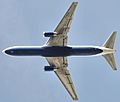Boeing 767 facts for kids
The Boeing 767 is a popular airplane made by Boeing. It's known as a "widebody" aircraft because it has two aisles inside, making it feel more spacious. Even though it's a large plane, it's Boeing's smallest widebody. It's bigger than the Boeing 757 but smaller than the 777. Passengers usually sit with two seats by the window, then an aisle, then three seats in the middle, another aisle, and finally two more seats by the other window. This plane can carry between 375 and 410 passengers.
A Boeing 767 was the type of airplane involved in a tragic event at the World Trade Center on September 11, 2001.
Many airlines around the world use the Boeing 767, including American Airlines, United Airlines, Delta Air Lines, Continental Airlines, and British Airways. The engines for these planes can be made by different companies like Rolls-Royce, General Electric, or Pratt and Whitney.
The Boeing 767 has been built since 1981 and is still being made today! Boeing plans to replace it with a newer model called the 787 Dreamliner.
Contents
What is a Widebody Airplane?
A widebody airplane is a type of aircraft that has a very wide body, wide enough for two aisles. This design allows for more seats in each row and more space for passengers. The Boeing 767 is a great example of a widebody plane, even if it's on the smaller side compared to giants like the Boeing 747 or 777.
Different Versions of the Boeing 767
Over the years, Boeing has made several versions of the 767. These different models are often called "variants."
- 767-200: This was the first version of the plane. It was introduced by United Airlines in 1982.
- 767-300: This version is longer than the -200, meaning it can carry more passengers or cargo. Most 767s sold are this type.
- 767-400ER: This is an even longer version, designed for longer flights. It was first shown to the public in 1999.
- 767-300F: The "F" stands for "Freighter." This version is built to carry cargo instead of passengers. Companies like UPS Airlines use these planes to deliver packages around the world.
Some 767s also have special parts called "winglets" on the ends of their wings. These help the plane fly more efficiently and save fuel.
Who Uses the Boeing 767?
Many airlines use the Boeing 767 for passenger flights. It's popular for both domestic flights (within a country) and international flights (between countries). Besides passenger airlines, cargo companies like FedEx Express and UPS Airlines use the freighter versions to transport goods. The 767 is known for being reliable and efficient, which is why so many companies choose it.
| Boeing 7x7 aircraft timeline, 1955–now | ||||||||||||||||||||||||||||||||||||||||||||||||||||||||||
|---|---|---|---|---|---|---|---|---|---|---|---|---|---|---|---|---|---|---|---|---|---|---|---|---|---|---|---|---|---|---|---|---|---|---|---|---|---|---|---|---|---|---|---|---|---|---|---|---|---|---|---|---|---|---|---|---|---|---|
| 1950s | 1960s | 1970s | 1980s | 1990s | 2000s | 2010s | ||||||||||||||||||||||||||||||||||||||||||||||||||||
| 1955 | 1956 | 1957 | 1958 | 1959 | 1960 | 1961 | 1962 | 1963 | 1964 | 1965 | 1966 | 1967 | 1968 | 1969 | 1970 | 1971 | 1972 | 1973 | 1974 | 1975 | 1976 | 1977 | 1978 | 1979 | 1980 | 1981 | 1982 | 1983 | 1984 | 1985 | 1986 | 1987 | 1988 | 1989 | 1990 | 1991 | 1992 | 1993 | 1994 | 1995 | 1996 | 1997 | 1998 | 1999 | 2000 | 2001 | 2002 | 2003 | 2004 | 2005 | 2006 | 2007 | 2008 | 2009 | 2010 | 2011 | 2012 | 2013 |
| Boeing 707 | ||||||||||||||||||||||||||||||||||||||||||||||||||||||||||
| Boeing 717 (MD-95) | ||||||||||||||||||||||||||||||||||||||||||||||||||||||||||
| Boeing 727 | ||||||||||||||||||||||||||||||||||||||||||||||||||||||||||
| Boeing 737 | ||||||||||||||||||||||||||||||||||||||||||||||||||||||||||
| Boeing 747 | ||||||||||||||||||||||||||||||||||||||||||||||||||||||||||
| Boeing 757 | ||||||||||||||||||||||||||||||||||||||||||||||||||||||||||
| Boeing 767 | ||||||||||||||||||||||||||||||||||||||||||||||||||||||||||
| Boeing 777 | ||||||||||||||||||||||||||||||||||||||||||||||||||||||||||
| Boeing 787 | ||||||||||||||||||||||||||||||||||||||||||||||||||||||||||
| = Not being made anymore | = Still being made | |||||||||||||||||||||||||||||||||||||||||||||||||||||||||
Images for kids
-
The 767 pictured here made its Farnborough Airshow debut in 1982 as the 767-200. Later it was named the Spirit of Delta Ship 102 with Delta Airlines.
-
Forward view of a Continental Airlines 767-400ER, showing fuselage profile, wing dihedral, and CF6 engines
-
The first 767-200 built, N767BA, in flight near Mount Rainier in the 1980s
-
Final assembly of a 767-300F at Boeing's Everett factory, which was expanded for 767 production in 1978
-
The 767-200 was introduced by United Airlines on September 8, 1982.
-
A JAL 767-300 lands in front of an ANA 767-300ER at Kansai Airport. The -300 and -300ER variants account for almost two–thirds of all 767s sold.
-
Austrian Airlines 767-300ER with blended winglets, which reduce lift-induced drag
-
The 767 is a widebody with a low wing, twin underwing turbofans, and a conventional tail.
-
The 767 has the same cockpit windows as the Boeing 757.
-
Economy class with two aisles and seven seats per row in 2–3–2 layout
-
TWA began operating the first 767-200 ETOPS flights in May 1985.
-
United Airlines introduced the 767-200 in 1982.
-
A 767-200ER of its launch customer, El Al. The -200ER is externally similar to the -200.
-
A 767-300 of its launch customer, Japan Airlines
-
American Airlines introduced the 767-300ER in 1988. This example was retrofitted with winglets.
-
A FedEx Express 767-300F
-
A 767-400ER of Continental Airlines, its launch customer
-
LAN Airlines 767-300ER in anniversary scheme at Madrid–Barajas Airport in 2009
-
Ukraine International Airlines 767-300ER with optional winglets
-
"The Spirit of Delta" at the Delta Air Lines Air Transport Heritage Museum
See also
 In Spanish: Boeing 767 para niños
In Spanish: Boeing 767 para niños


























